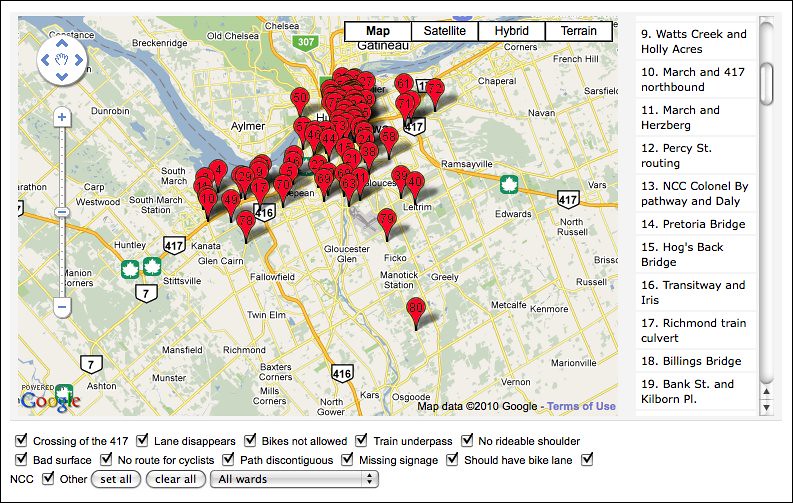This past week the City launched a “Cycling Safety Evaluation Project”. A major component of the project is an online survey that asks cyclists to identify “the most hazardous intersections they encounter” on the streets of Ottawa. It’s a much-needed and long-overdue initiative, so it’s no surprise that news of it spread quickly through social media networks; in fact one well-know cyclist-blogger has already completed the survey and posted her reaction to it.
But frustration with the state of Ottawa’s often-hazardous cycling infrastructure has already led a local cyclist to launch a similar online exercise. The excellent Ottawa Biking Problems has detailed reports from 80 of the region’s most hazardous cycling trouble spots, mapped out from Hull in the north to Manotick in the south, and Blackburn Hamlet in the east to March Road in the west.
Alex deVries is the man behind OBP, and this week he spoke with us about his experiences as an Ottawa cyclist and the cycling community’s reaction to his site.
Q. Was there a certain experience that made you determined to get the site up? Perhaps an incident, or a realization?
My commute to work is the length of Carling, and there’d been a sewer grate rotated at Richmond that could catch a bike wheel easily. I’d ridden over that spot for four years and complained in my mind every single time. One Tuesday morning I whipped off an email to 311@ottawa.ca, and it was fixed on Thursday. I realized that if I’d taken two minutes to report that, I’d have made my commute a lot easier. That was two years ago.
I’ve had a few close calls riding on the western part of Carling, where an 80km/hr road with no functional shoulder narrows to go under a train bridge. I could never get the attention of politicians or the city. In March of this year, I put up http://www.bikingoncarling.ca to help explain the problem to others. The most common response I got from cyclists was “hey, that’s great, but I have all these other problems…”.
I’d written and edited various Wikipedia articles in the last few years, so understood some of the power of user-generated content. Experienced cyclists understand their routes very well, but no one cyclist can know them all. OBP is a site that brings that distributed information into one place. I’m trying to get cyclists to be heard, and to make sure they know they’re not alone.
Q. Is their a ‘most notorious’ example of dangerous Ottawa cycling infrastructure?
We’re working on putting together two top-ten lists: one problems with easy fixes, and another for larger problems. We’re not ready to distribute the lists yet, but I’ll describe a couple of my favourites.
A classic postcard scene of Ottawa is of cyclists leisurely riding on the NCC path between Colonel By and the canal towards downtown. It looks great, but to get somewhere you’d actually want to go (downtown, the National Gallery, the Rideau Centre), you’d need to first ignore the NCC sign that points the wrong way, bike on a path that might or might not be a bike path, dismount to cross Colonel By at a pedestrian crossing, and finally ride in busy traffic.
Another good one is on the NCC Ottawa River pathway where it crosses Booth St. near the War Museum. There is no bicycle crossing, so cyclists are supposed to dismount, hit the pedestrian crossing button and wait. The delay can be 4 minutes, which infuriates the thousands of cyclists who commute by there every day. Cyclists get frustrated and just ride across the red light.
Q When did the site go up, and how has the response been so far from the cycling community?
We’ve been up since around May. Cyclists’ responses have been consistently positive.
What’s most rewarding is getting feedback from people who bike and are in no way connected to any cycling organization. Those are people Citizens for Safe Cycling and other organizations haven’t reached.
Q. You’ve got a rich data set on the site; what are your thoughts about the survey the City just announced this week –is it trying to get the same sort of responses you have already elicited?
The city’s survey came after various discussions with Citizens for Safe Cycling and me; we’re happy the city is gathering this information.
At OBP, we can publish anything we want, whenever we want. By publishing the reports as they come in, we get a lot of “me too” comments, or corrections on existing reports. We’re also better able to traverse jurisdictional boundaries, as cyclists use a mixture of both NCC and City of Ottawa facilities.
The survey also tries to collect information around cyclists’ riding habits.
Q. What would you most like to see on the site that is not there now?
Right now, OBP is a good place for cyclists to go and complain. The next step is to generate practical reports that can help affect change. We’re going to be publishing our Top Ten lists, which will make it easier for the media, politicians and voters to understand.
Q. Can volunteers help out with OBP?
There’s always an outstanding list of new entries, so editing and creating content is important. There are also some technical features we’ll add at some point, particularly around a better way to submit problems and browsing problems.


2 comments
Very interesting post, thanks!
The link in the first paragraph (“posted her reaction”) doesn’t work for me, nor does the “biking on Carling” link (missing the “www”).
Craig
Thanks for that Hibou- we’ve fixed the links.